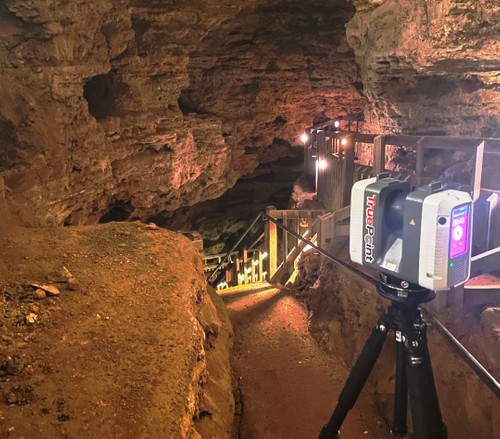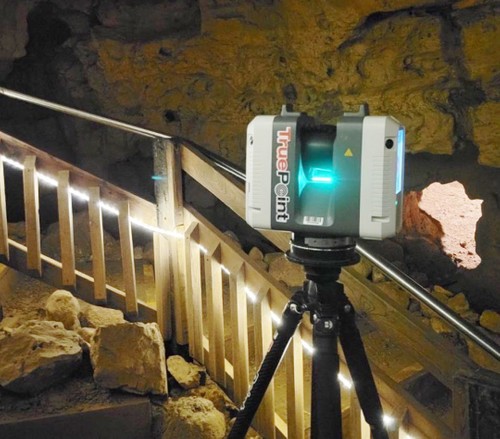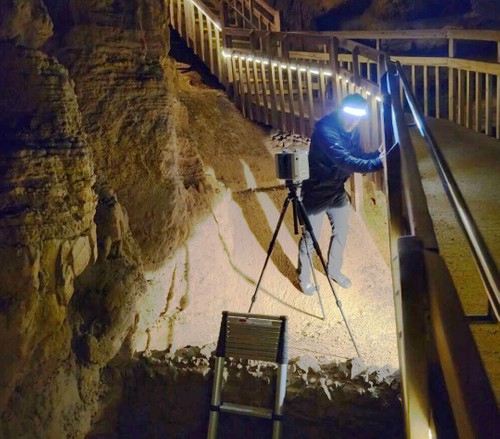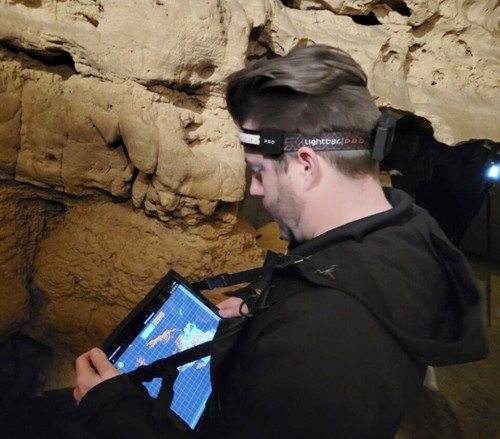3D Laser Scanning Inside Wisconsin Cave

Project Manager Cole Dickson was tasked with 3D laser scanning inside a Wisconsin cave where the owners were preparing to overhaul the stairs and walkways that carry visitors throughout the tourist destination.
“The engineer on-site was blown away and excited about how accurate our data was. He wants me to come back and document the rest of the cave for him.” -- Cole Dickson
Best office ever.
That’s what TruePoint Project Manager Cole Dickson kept saying to himself as he carefully positioned his Leica RTC360 3D laser scanner on top of the craggy, unforgiving bedrock under his boots.
Dickson was tasked with 3D laser scanning inside a Wisconsin cave where the owners were preparing to overhaul the stairs and walkways that carry visitors throughout the tourist destination. The existing wooden structures were decades old, and the high humidity inside the cave – almost 100% year-round – had taken its toll.
“They wanted to build aluminum or steel structures instead of wooden stairwells and walkways in there, just to make it sturdier and safer for people coming through,” Dickson said.
The client had installed a steel handrail a few years prior, and they told Dickson that this relatively simple project quickly turned into a massive headache. Using traditional methods, it took them days to obtain proper measurements inside the cavern.

Project Manager Cole Dickson was able to collect a total of 38 scans in four hours inside a Wisconsin cave.
“One of the major challenges is that, in a cave, nothing is square,” Dickson said. “From an engineering standpoint, that’s really difficult for them when they need to take measurements and be able to make precise calculations on whatever they’re crafting in the cave.”
In just four hours on-site, Dickson took a total of 38 scans of the cave’s walkway, stairwells, and the area immediately surrounding the structures. He primarily used the Leica RTC360 3D laser scanner, a long-range laser scanner that captures and automatically pre-registers scans in real-time with 2-4 mm accuracy. He also utilized the Leica P40 ScanStation, which delivers the highest-quality point cloud data and HDR imagery, capturing 1 million points per second with a range of more than 1 kilometer.
“I was tasked to scan the entire walkway, stairwells, and then the surrounding area underneath and around the walkway just so they have spatial awareness and understanding of the layout of the cave floor, and all the slopes and geometry there to be able to quickly have calculation and understanding of the layout,” Dickson said.

Five days after laser scanning, the point cloud was delivered to the client.
We know that time is money, and so we pride ourselves on the quick turnaround of our clients’ deliverables. In the case of Dickson’s visit to the cave in Wisconsin, the client received the point cloud data within a week of the site being scanned.
“Caves are such a cool atmosphere… I was super excited to hear about this project, and I wanted to give the client a great price and a great product,” Dickson said. “They had all the data that they needed and were able to get to work on what they wanted to do.”
Dickson clearly made a good impression during his time in Wisconsin.

The engineer on-site wants TruePoint to come back document the rest of the cave for him.
“The engineer that was on-site with me was just so blown away and excited about how accurate our data was, and he wants me to come back just to document the rest of the cave for him,” he said. “So, there’s the potential to go back, which would be really exciting and something that I really want to work towards.”
When you’re a TruePoint Project Manager, you never know what the next day might bring. Just a few days after finishing up his work in Wisconsin, Dickson was in Nevada scanning inside a water treatment facility.
A few days after that, Dickson was in Oklahoma City scanning inside the Lloyd Noble Center, home of the University of Oklahoma men's and women's basketball teams.
“I think my favorite thing about this job is being able to see all the behind-the-scenes stuff that working an office job, or just in a different industry, you don’t get to see,” Dickson said. “I’m really interested in getting to talk to whoever is on-site and understanding whatever project I’m at.”
Whatever the job entails, TruePoint has the people and the technology to help you Intelligently Visualize The Built World™.
- For 3D laser scanning services in Wisconsin call or email:
- Green Bay | 920-510-4467 | greenbay@truepointscanning.com
Madison | 608-250-0690 | madison@truepointscanning.com
